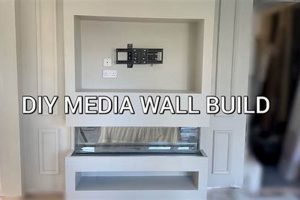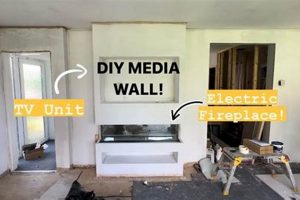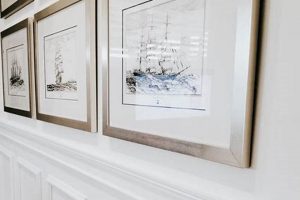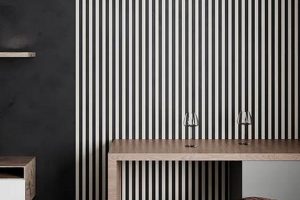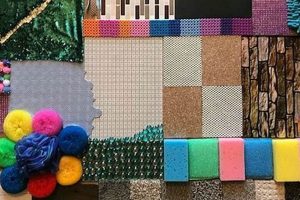Decorative trim applied to walls by individuals enhances interior aesthetics. These enhancements, often constructed from materials like wood, PVC, or MDF, introduce texture and visual interest to flat surfaces. For example, installing a series of rectangular frames on a wall adds architectural detail and a sense of sophistication.
The application of such features offers several advantages, including increased property value, improved room ambiance, and the opportunity for personalized design expression. Historically, wall ornamentation has been a hallmark of affluent homes, demonstrating craftsmanship and attention to detail. Today, accessible materials and simplified techniques enable homeowners to achieve similar results without professional assistance.
The subsequent sections will explore the various types of decorative wall features available, detailing the necessary tools and materials, and outlining the step-by-step installation process to achieve a professionally finished look.
Essential Tips for Installing Decorative Wall Trim
Successful application of decorative wall features requires meticulous planning and execution. The following guidelines ensure a professional and lasting result.
Tip 1: Precise Measurement and Planning: Accurate dimensions are paramount. Prior to cutting any material, measure the wall space meticulously and create a detailed layout. Account for corners, obstacles (outlets, switches), and desired spacing between features.
Tip 2: Material Selection: Choose materials appropriate for the environment and aesthetic. MDF is suitable for painted surfaces in dry areas. PVC is moisture-resistant and ideal for bathrooms or kitchens. Solid wood offers durability and a classic appearance.
Tip 3: Proper Cutting Techniques: Utilize a miter saw for precise angle cuts. Ensure the blade is sharp and appropriate for the chosen material. Practice on scrap pieces to achieve clean, accurate cuts before working with the final material.
Tip 4: Secure Adhesion: Select an appropriate adhesive based on the wall surface and trim material. Apply adhesive evenly and in sufficient quantity to ensure a strong bond. Consider using construction adhesive for heavy or complex installations.
Tip 5: Leveling and Alignment: Employ a level to ensure horizontal and vertical accuracy. Use shims to correct any imperfections in the wall surface. Consistent alignment is crucial for a professional finish.
Tip 6: Filling Gaps and Seams: Fill any gaps or seams with paintable caulk. Apply caulk smoothly and evenly, and wipe away excess with a damp cloth. This creates a seamless transition between the trim and the wall.
Tip 7: Priming and Painting: Prime the trim before painting to ensure proper adhesion and a uniform finish. Apply multiple thin coats of paint rather than one thick coat to avoid drips and runs. Allow each coat to dry completely before applying the next.
These tips emphasize the importance of precision and attention to detail. By adhering to these guidelines, individuals can achieve a professional-quality result when enhancing walls with decorative trim.
The subsequent article sections will delve into common design patterns and provide examples of successful wall trim applications.
1. Material Selection
The selection of appropriate materials is paramount when undertaking decorative wall trim projects. The chosen material directly impacts the aesthetic, durability, and ease of installation of the finished product. Careful consideration should be given to the characteristics of each material relative to the specific application.
- MDF (Medium-Density Fiberboard)
MDF offers a smooth, consistent surface ideal for painting. Its affordability makes it a popular choice. However, MDF is susceptible to moisture damage and is therefore unsuitable for use in bathrooms or kitchens. A common application is in living rooms or bedrooms where humidity levels are controlled.
- PVC (Polyvinyl Chloride)
PVC provides excellent moisture resistance, rendering it suitable for environments with high humidity or direct exposure to water. It is also resistant to rot and insects. PVC trim is often used in bathrooms, kitchens, and basements. While more expensive than MDF, its durability in damp conditions justifies the cost.
- Solid Wood
Solid wood offers a classic aesthetic and inherent strength. Wood species such as pine, oak, and poplar are commonly used. Solid wood is generally more expensive than MDF or PVC and requires proper sealing and finishing to prevent warping and cracking. It is well-suited for high-end installations where a natural wood grain appearance is desired.
- Polystyrene
Polystyrene provides a lightweight and affordable alternative. It is relatively easy to cut and install but may not offer the same level of durability as MDF, PVC, or solid wood. Polystyrene trim is often used for purely decorative purposes in areas with low traffic and minimal potential for impact.
The interplay between material properties and environmental factors is crucial. The selection process should prioritize longevity and aesthetic harmony. Failure to consider these factors can lead to premature failure or an unsatisfactory appearance, ultimately undermining the effort invested in enhancing walls with decorative trim.
2. Precise Measurements
The accurate assessment of dimensions constitutes a foundational element in the successful execution of decorative wall trim projects. Imprecise measurements can lead to material waste, misaligned features, and an overall unprofessional appearance. Rigorous adherence to accurate measurement practices is therefore essential.
- Wall Area Calculation
Determining the exact area of the wall to be adorned is the initial step. This involves measuring the length and height of each wall segment, accounting for any irregularities or obstructions such as windows, doors, or architectural protrusions. Accurate calculation allows for the appropriate quantity of materials to be procured, minimizing waste and cost overruns. An example includes calculating the perimeter of a room to determine the total length of baseboard needed.
- Molding Length Determination
The length of each individual molding piece must be precisely determined based on the design layout. This includes accounting for corner angles, intersections, and the desired spacing between moldings. Miscalculation of these lengths results in gaps, overlaps, or misaligned patterns. A common scenario involves calculating the length of a horizontal chair rail, requiring precise measurements to ensure it aligns seamlessly around the room.
- Angle Measurement for Miter Cuts
Corner joints require accurate angle measurements to ensure a seamless fit. Miter saws are typically used to create these angled cuts, and the accuracy of the cut is directly dependent on the precision of the angle measurement. Failure to measure angles accurately results in visible gaps and an unprofessional finish. For example, accurately measuring the angle of an inside corner (typically 90 degrees) allows for the creation of two 45-degree miter cuts to form a perfect joint.
- Level and Plumb Verification
Ensuring that the wall surface is level and plumb is critical for proper molding alignment. A level is used to verify horizontal accuracy, while a plumb bob or level ensures vertical accuracy. Adjustments must be made to compensate for any deviations from level or plumb. Inaccurate leveling and plumbing can result in moldings that appear crooked or uneven. An example is using shims behind the molding to correct minor wall imperfections and ensure a perfectly level installation.
These considerations underscore the integral role of precise measurements in achieving professional-quality decorative wall trim installations. Accurate dimensions, coupled with proper technique, are necessary to transform a concept into a visually appealing and structurally sound reality.
3. Cutting Techniques
Cutting techniques represent a critical determinant of success in decorative wall trim projects. Precise and accurate cuts are essential for creating seamless joints, maintaining consistent patterns, and achieving a professional aesthetic. The selection and application of appropriate cutting methods directly impact the final appearance and structural integrity of the wall enhancement. Inaccurate cuts can result in visible gaps, misaligned corners, and a compromised overall design. For instance, the use of a dull blade during a miter cut can lead to splintering and uneven edges, necessitating rework and material wastage. Conversely, a clean, precise cut ensures a tight, visually appealing joint that enhances the overall quality of the installation.
The specific cutting technique employed is contingent upon the material selected and the complexity of the design. Miter saws are frequently utilized for creating angled cuts required for corner joints, while coping saws offer greater precision for intricate shapes and profiles. Proper clamping and support during the cutting process are vital to prevent movement or vibration that could compromise accuracy. A real-world example involves the creation of a picture-frame molding design. Each piece of molding must be cut to the exact length and angle to create a perfect rectangle on the wall. Even a slight error in the cutting process will result in a distorted shape and detract from the intended visual effect.
In summary, mastery of cutting techniques is indispensable for achieving high-quality results. A thorough understanding of various cutting tools, methods, and materials is essential for overcoming common challenges and ensuring a successful wall trim installation. The ability to execute precise cuts translates directly into a finished product that reflects craftsmanship and attention to detail, elevating the overall aesthetic of the space. This skill, when honed, allows for complex patterns and customized designs, greatly expanding the creative potential of decorative wall treatments.
4. Adhesive Application
The selection and application of adhesives are crucial to the longevity and aesthetic integrity of decorative wall trim installations. Proper adhesion ensures that the moldings remain securely affixed to the wall surface, preventing detachment and maintaining the intended visual design. The adhesive acts as the primary bonding agent, compensating for minor surface irregularities and providing the necessary holding power.
- Surface Preparation
Proper surface preparation is essential for optimal adhesive bonding. This involves cleaning the wall surface to remove dust, dirt, grease, and any loose paint or wallpaper. A clean, dry surface provides a suitable substrate for the adhesive to grip. Failure to adequately prepare the surface can result in weak adhesion and premature failure of the bond. This step includes patching holes or cracks and sanding uneven surfaces to promote proper contact.
- Adhesive Selection
Choosing the appropriate adhesive type is dictated by the material of the molding and the wall surface. Construction adhesives are commonly used for their strong bonding capabilities and ability to bridge gaps. Specific adhesives are formulated for use with materials such as wood, MDF, PVC, and polystyrene. Using the wrong adhesive can result in poor adhesion, material damage, or chemical incompatibility. For example, using a water-based adhesive on MDF in a humid environment can cause the MDF to swell and delaminate.
- Application Technique
The manner in which the adhesive is applied directly affects the strength and durability of the bond. Adhesives should be applied evenly and in sufficient quantity to ensure full contact between the molding and the wall surface. Excessive adhesive can create a messy appearance and may not necessarily increase the bond strength, while insufficient adhesive can lead to weak spots and potential detachment. The type of application (e.g., beads, dots, or full coverage) should be appropriate for the size and weight of the molding. For instance, heavy moldings may require a continuous bead of adhesive along the entire contact surface.
- Curing Time and Support
Allowing adequate curing time is critical for the adhesive to achieve its full bonding strength. Curing times vary depending on the adhesive type, temperature, and humidity. During the curing process, it may be necessary to provide temporary support to the moldings to prevent them from shifting or detaching. This can be achieved using painter’s tape, clamps, or temporary fasteners. Premature removal of support before the adhesive has fully cured can compromise the bond and lead to misalignment or detachment.
These facets highlight the interdependence between adhesive properties, application techniques, and environmental factors. Mastery of adhesive application is crucial for ensuring the long-term stability and aesthetic appeal of decorative wall trim installations. Selection and proper use contribute directly to the success and satisfaction with the wall trim enhancement project.
5. Finishing Touches
Finishing touches constitute the terminal, yet critical, phase in the execution of “diy wall moldings” projects, directly influencing the final visual impact and perceived quality. This stage encompasses processes such as caulking, filling nail holes, sanding, priming, and painting, each contributing to a seamless and professional appearance. Inadequate attention to these details can negate the efforts invested in earlier stages, resulting in visible imperfections and a diminished aesthetic. For example, neglecting to caulk seams between the moldings and the wall can create noticeable gaps, disrupting the intended uniformity and detracting from the overall design. Conversely, meticulous caulking and painting conceal imperfections, creating a polished and refined look that elevates the perceived value of the installation.
The impact of finishing touches extends beyond mere aesthetics; it also affects the longevity of the “diy wall moldings.” Proper sealing and painting protect the underlying materials from moisture and other environmental factors that can cause deterioration over time. For instance, applying a high-quality primer and paint to MDF moldings prevents moisture absorption, reducing the risk of swelling, warping, or mold growth. Furthermore, addressing minor imperfections during the finishing stage, such as filling nail holes and sanding rough edges, enhances the durability and resistance to everyday wear and tear. A real-world example illustrates this point: properly sealed and painted PVC moldings in a bathroom environment are far less susceptible to water damage compared to unfinished or poorly finished moldings.
In summary, the finishing touches phase of “diy wall moldings” is not merely cosmetic but essential for achieving a visually appealing, durable, and professional outcome. Neglecting this stage can undermine the entire project, while meticulous execution elevates the result to a level that rivals professional installations. Therefore, prioritizing and investing in quality finishing techniques are vital to realizing the full potential of “diy wall moldings,” ensuring long-term satisfaction and adding value to the interior space. The level of detail provided during this stage is paramount for success.
Frequently Asked Questions
The subsequent questions address common concerns and misconceptions associated with the installation of decorative wall features. This information is intended to provide clarity and guidance to individuals undertaking such projects.
Question 1: What is the expected lifespan of decorative wall features?
The lifespan of decorative wall features is contingent upon several factors, including material selection, installation quality, and environmental conditions. Properly installed and maintained features constructed from durable materials, such as solid wood or PVC, can last for decades. However, features made from less durable materials, such as MDF, may have a shorter lifespan, particularly in humid environments.
Question 2: Are specialized tools required for this type of installation?
While basic tools such as a measuring tape, level, and utility knife are essential, certain specialized tools can significantly improve the efficiency and accuracy of the installation process. A miter saw is highly recommended for making precise angled cuts, and a nail gun or brad nailer can expedite the attachment of moldings to the wall surface.
Question 3: How can warping or cracking of wood moldings be prevented?
To minimize the risk of warping or cracking in wood moldings, it is essential to acclimate the wood to the room’s humidity level for several days prior to installation. Additionally, sealing and finishing the wood with a high-quality paint or sealant helps to protect it from moisture fluctuations.
Question 4: What is the best method for filling nail holes and seams?
Nail holes and seams can be effectively filled with paintable caulk or wood filler. Apply the filler sparingly and evenly, and allow it to dry completely before sanding smooth. Ensure that the filler is compatible with the chosen paint or finish.
Question 5: How does one determine the appropriate spacing between moldings?
The spacing between moldings is largely a matter of personal preference and aesthetic design. However, it is generally advisable to maintain consistent spacing throughout the room to create a cohesive and balanced look. Consider the size of the wall and the scale of the moldings when determining the appropriate spacing.
Question 6: What are the safety precautions to consider during the installation process?
Safety is paramount during any home improvement project. Always wear appropriate safety gear, including eye protection and gloves. When using power tools, follow the manufacturer’s instructions carefully and be mindful of potential hazards. Ensure that the work area is well-ventilated, and dispose of waste materials properly.
In conclusion, addressing potential issues and employing proper techniques are crucial for successful decorative wall feature installations. Informed decision-making contributes to a durable and aesthetically pleasing result.
The following section provides a summary of the benefits of decorative wall features.
Conclusion
The preceding exposition has detailed various aspects of diy wall moldings, from material selection and measurement precision to cutting techniques, adhesive application, and finishing touches. Mastery of these elements is essential for achieving a professional-quality result. Furthermore, an understanding of common issues, such as warping and seam visibility, enables informed decision-making and effective problem-solving during the installation process. The choice of materials must align with the intended environment and design aesthetic to ensure both durability and visual appeal. Accurate execution from start to finish is paramount for the lasting success of this undertaking.
Effective employment of diy wall moldings represents a tangible investment in interior space, enhancing property value and fostering a sense of personalized design. Continued adherence to established best practices and a commitment to detail will ensure the continued relevance and appreciation of this enduring decorative technique. The ability to enhance interior spaces with wall features is a testament to individual skill and attention to detail. Careful planning and execution contribute to an end result that may add value to any property and provide visual enrichment to any room.


